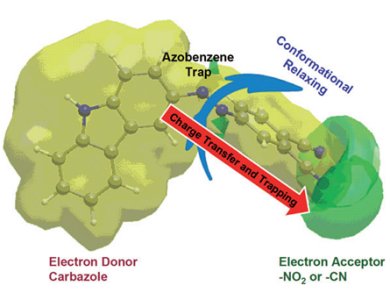The field of polymer-based electronic devices has led to advances in organic light-emitting diodes, organic transistors, and solar cells. The advantages of using polymers-derived devices over inorganic semiconductor devices includes high mechanical flexibility and low fabrication cost. Electronic memory devices with the Al/polymer/indium−tin oxide sandwich structure have been studied in collaboration with the teams of Yu Chen and En-Tang Kang from East China University and the National University of Singapore, respectively. The devices were fabricated using two different poly(N-vinylcarbazole) derivatives containing pendant azobenzene chromophores in donor−trap-acceptor structures (pictured).
The memory effects of these write-once-read-many (WORM) memory devices were cast on a glass substrate and their “ON”/”OFF” switching states investigated. The observed switching and conduction mechanism is supported by evidence gathered from computational methods, UV/Visible absorption spectra, core-level X-ray photoelectron spectra, and high-resolution transmission electron microscopy images. The electrical bistability observed can be attributed to field-induced charge-transfer interactions and subsequent charge trapping at the azobenzene chromophores.
Image: ©: Wiley-VCH
- Electrical Bistability and WORM Memory Effects in Donor-Acceptor Polymers Based on Poly(N-vinylcarbazole)
Bin Zhang, Gang Liu, Yu Chen,* Cheng Wang, Koon-Gee Neoh, Ting Bai, En-Tang Kang,
ChemPlusChem 2011.
DOI: 10.1002/cplu.201100007




